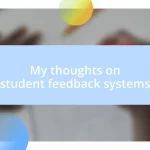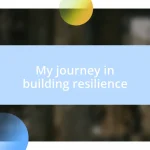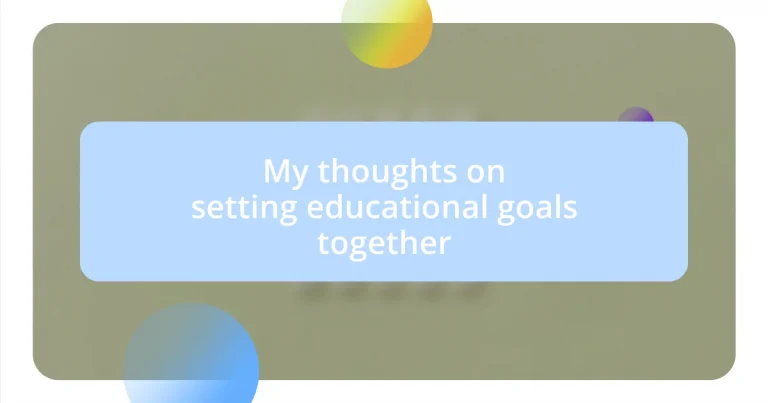Key takeaways:
- Setting educational goals provides direction, fosters accountability, and promotes personal growth beyond academic achievements.
- Involving students in goal setting enhances motivation and ownership of their learning, facilitated by self-reflection and celebration of small wins.
- Adjusting goals as needed is crucial for managing stress, allowing flexibility, and focusing on skill-building over merely pursuing grades.
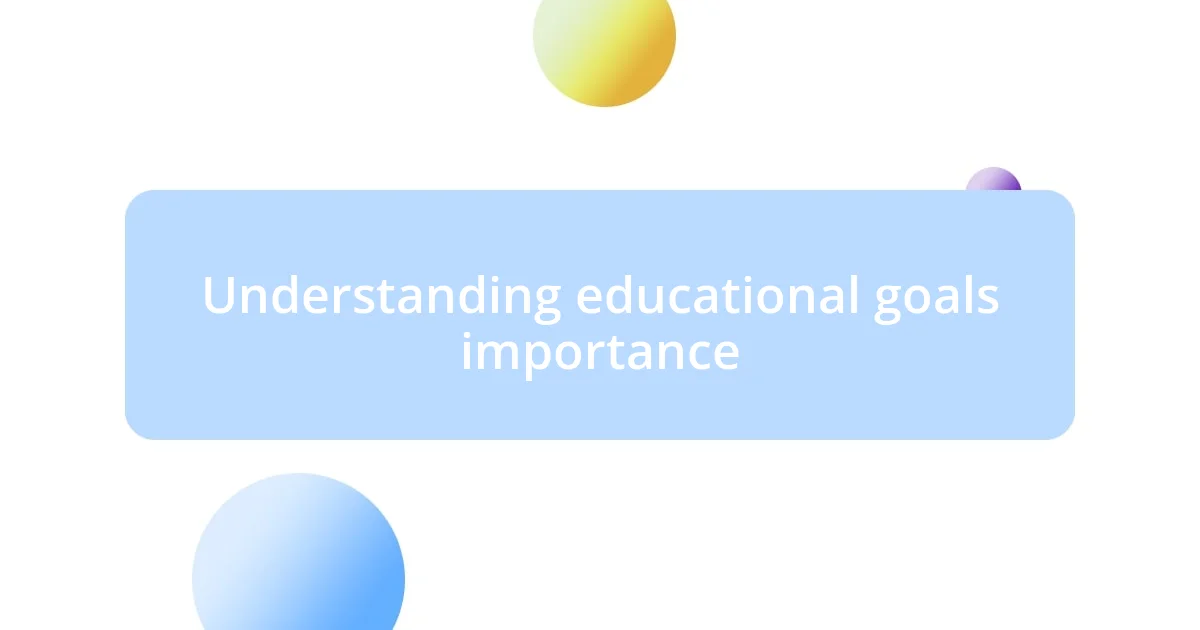
Understanding educational goals importance
The importance of educational goals can’t be overstated, as they serve as a roadmap for both students and educators. I remember the day I sat down to map out my own educational objectives; it was like flipping on a switch. Suddenly, my path felt clearer, and I could see how each step aligned with my aspirations. Have you ever felt lost without direction? Setting goals can anchor you in an ever-changing landscape of information and choices.
Moreover, these goals encourage accountability and motivation. For instance, when I set my sights on achieving a specific grade in a challenging subject, it ignited a spark in me. That commitment drove me to study differently, seek help, and ultimately succeed. It made me wonder: how often do we underestimate the power of goal-setting in cultivating resilience and grit?
Finally, educational goals promote personal growth beyond academic achievements. Reflecting on this, I find that each time I achieved a milestone, it wasn’t just about the grade; it was about the confidence I gained in my abilities. How do you feel when you accomplish a goal? Understanding this emotional payoff can deepen our appreciation for the process of learning itself.
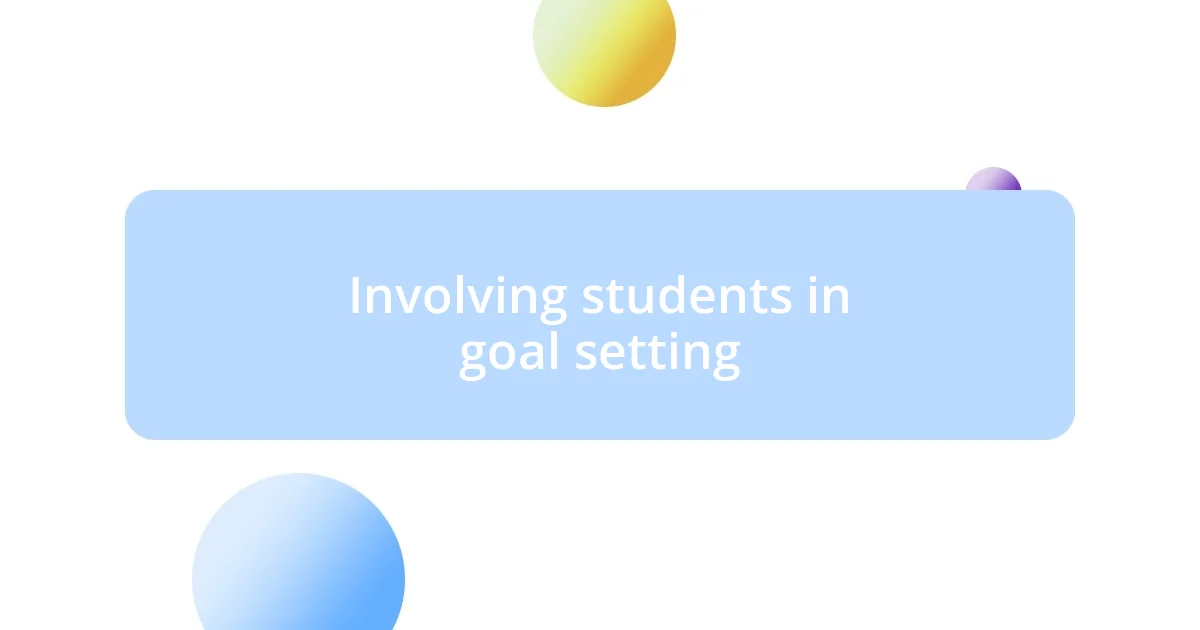
Involving students in goal setting
Involving students in goal setting transforms the educational experience, creating a sense of ownership in their learning journey. I remember working with a group of students on their individual projects; they were not just following instructions but actively participating in shaping their objectives. This collaboration not only built their confidence but also made them more invested in their learning outcomes. When students see their interests reflected in their goals, it cultivates both motivation and engagement.
Here are some ways to effectively involve students in the process of goal setting:
– Encourage self-reflection: Ask students to consider their strengths, weaknesses, and interests.
– Facilitate open discussions: Create a safe space for students to share their aspirations and fears regarding their educational journey.
– Use visual aids: Incorporating charts or diagrams can help students visualize their aspirations and progress.
– Set SMART goals: Teach students to create Specific, Measurable, Achievable, Relevant, and Time-bound goals, which clarify their focus.
– Celebrate small wins: Recognizing their accomplishments, no matter how minor, can boost their confidence and foster a positive attitude towards future goals.
In my view, these strategies not only aid in defining clear objectives but also enhance students’ emotional investment in their educational paths.
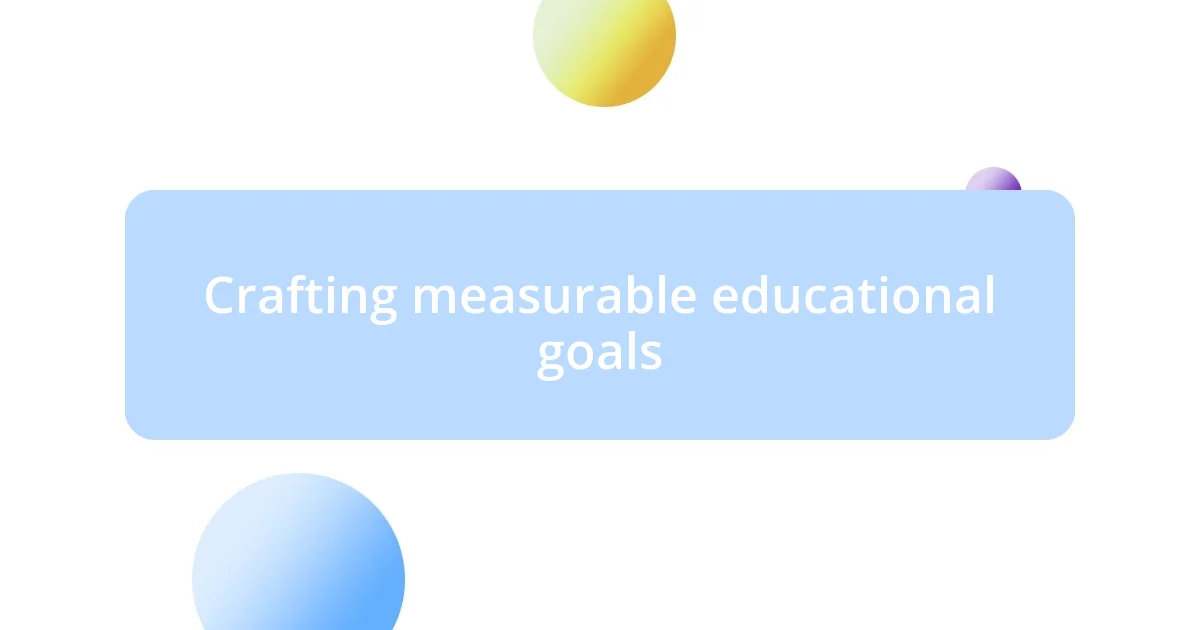
Crafting measurable educational goals
Setting measurable educational goals is essential for tracking progress and ensuring success. From my experience, having clear metrics helps to maintain focus. For instance, when I aimed to improve my writing skills, I didn’t just say, “I want to write better.” Instead, I specified, “I will complete two essays each month.” This stark clarity made a significant difference in how I approached my tasks and monitored my improvement.
Additionally, it’s important to revisit these goals regularly. I remember a period when I had set my sights on mastering a language. Initially, my goal was to learn 50 new vocabulary words each week. However, as I progressed, I realized this pace was overwhelming. So, I adjusted it to 30 words—still ambitious but more manageable. This kind of flexibility in crafting measurable goals proves invaluable, as it allows for personal adjustments based on experience.
Ultimately, employing the SMART criteria is an effective approach for creating measurable educational goals. By ensuring that goals are Specific, Measurable, Achievable, Relevant, and Time-bound, you set yourself up for success. Reflecting on my own educational journey, I recall how impactful it was to frame my goals in this way. It not only brought clarity but also kept me motivated through tangible checkpoints along the way.
| SMART Goal Component | Description |
|---|---|
| Specific | Clearly define what you want to achieve. |
| Measurable | Establish criteria for tracking progress. |
| Achievable | Set realistic goals that can be accomplished. |
| Relevant | Ensure goals align with broader objectives or interests. |
| Time-bound | Set a deadline for when the goal should be achieved. |
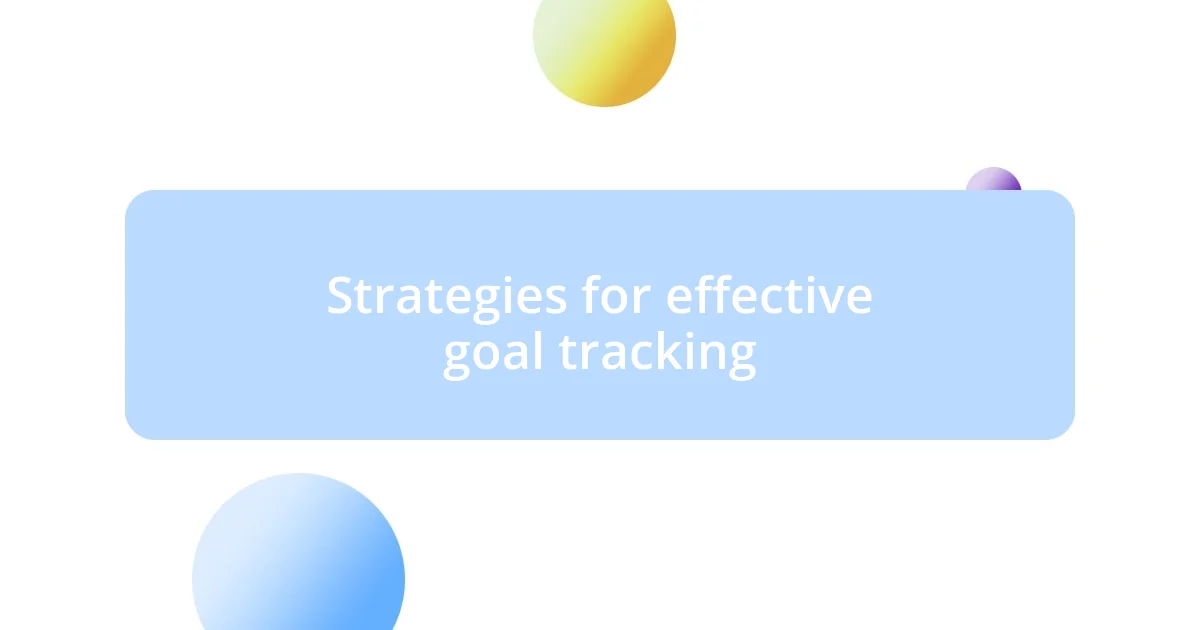
Strategies for effective goal tracking
Tracking educational goals effectively can feel like a daunting task, but I’ve found that breaking it down into digestible pieces makes a world of difference. I recall a semester when I decided to use a simple spreadsheet to track my study hours and project milestones. Each week, I would input my progress, and seeing that steady progression was incredibly motivating. It made me wonder—how often do we overlook the power of visualizing our achievements?
In addition to keeping a progress tracker, it’s beneficial to involve peer accountability. I had a study buddy during my exam preparation, and we held each other to our commitments. We struggled a bit at first, but soon, those check-in conversations became something I looked forward to. It was a reminder that we weren’t in this alone; we were working toward our goals together, which added a layer of encouragement that I hadn’t anticipated. How might collaborating with a fellow student reshape your approach to goal tracking?
Lastly, cultivating a habit of reflection is key. After each major task, I would spend time evaluating what strategies worked and what didn’t. On one occasion, I took a moment to think about a group project where I felt overwhelmed. By assessing that experience, I learned to break tasks down further and communicate better with my teammates. Embracing this reflective practice not only helped me track my goals more efficiently but also transformed how I approached new challenges. Isn’t it fascinating how personal growth can stem from simply taking the time to pause and reflect?
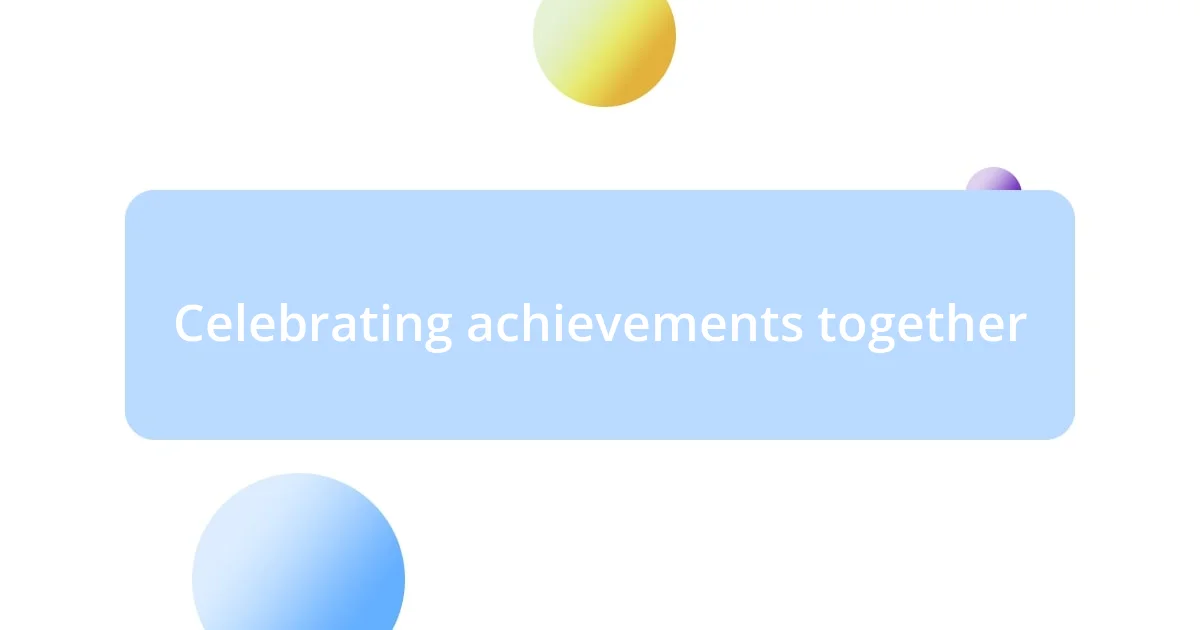
Celebrating achievements together
Celebrating achievements together is one of the most uplifting parts of the goal-setting journey. I remember the thrill of completing a challenging project alongside my classmates—when we received our grades, the excitement was palpable. We jumped up and hugged, sharing not just the joy of our individual successes but also the relief of our collaborative effort. That moment of celebration reinforced our bond and made the achievement all the more special. Isn’t it amazing how a shared victory can deepen relationships?
In my experience, establishing a ritual for celebrating milestones can make a considerable difference. For instance, I had a fantastic mentor who would host a small gathering whenever we reached a significant goal. The atmosphere was filled with laughter, stories, and reflections on our challenges. Those celebrations became a source of motivation for us, constantly reminding us that each achievement, no matter how small, deserved recognition. Don’t you think it’s essential to acknowledge even the little wins along the way?
Moreover, celebrating achievements can inspire future aspirations. After a particularly intense semester, I recall sharing a celebratory dinner with my peers. We talked about what we had accomplished and grabbed the chance to outline our next set of goals. Reflecting on our triumphs gave us the confidence to dream even bigger. This practice of acknowledgment not only energizes us but also creates a positive feedback loop, encouraging us to continue pursuing our ambitions. How powerful is it to transform past successes into fuel for future goals?
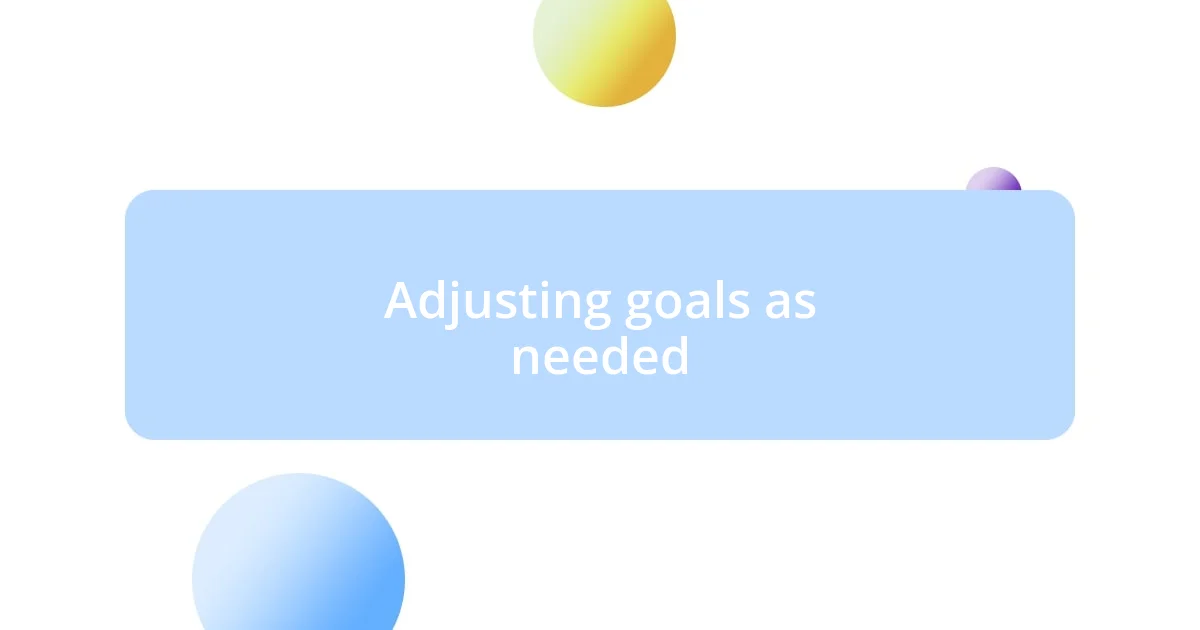
Adjusting goals as needed
Adjusting goals is an essential part of the educational journey. I’ve had moments where I set ambitious targets, only to realize they didn’t align with my current circumstances. For example, during one intense semester, I initially aimed for straight A’s but quickly recognized that this goal was unrealistic given my other responsibilities. When I adjusted my goal to focus on mastering the core concepts instead, it relieved an immense weight off my shoulders. Have you ever found yourself in a similar situation where a shift in focus was necessary?
Flexibility in goal-setting not only helps in managing stress but also opens the door to unexpected opportunities. I remember a time when a surprise class assignment challenged my original timelines, and instead of feeling defeated, I tweaked my study plan. By prioritizing that task for a few days, I was able to excel in both the assignment and my ongoing projects. This experience taught me that adapting isn’t a sign of failure; in fact, it often leads to enhanced learning. How might your educational experience improve by allowing for some necessary adjustments along the way?
Moreover, the process of reassessing goals has been a powerful reflection tool for me. It forces me to evaluate what truly matters for my personal and academic growth. I recall sitting down at the end of a project feeling quite drained, but after some reflection, I recognized that the skills I gained were more valuable than the grades themselves. I adjusted my future goals to prioritize skill-building over simply chasing high marks. Wouldn’t it be enlightening to realize that sometimes, recalibrating our focus can illuminate a path toward deeper understanding and fulfillment?








